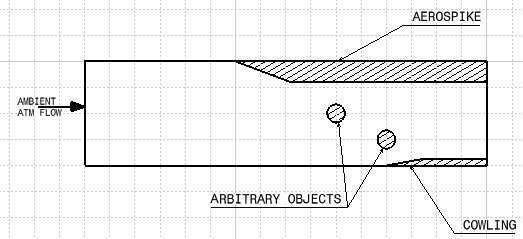Hypersonic flight is deemed to be the next frontier in aviation and thus, a lot of research is dedicated towards obtaining a concise understanding of the flow in this regime. Such vehicles are characterized by sharp edges and thus, the flow field consists of numerous oblique shocks. The principal phenomenon of interest in such flights is the location at which the oblique shocks impinge on the vehicle surface. The positioning of the oblique shocks is used productively to compress the air flowing into the propulsive system. The control of the shock impingement point is of vital importance and numerous methodologies have been proposed and employed over the years. The research in this paper puts forth a method for active control of shockwaves.
The flow field around a hypersonic vehicle is subjected to high rarefaction and degree of non-equilibrium. The Navier-Stokes based CFD study in such regions has misgivings and is thus, not a preferred methodology. In this research, we utilize the widely recognized, Direct Simulation Monte Carlo (DSMC), a kinetic particle based method. An in-house 2-D, parallel, multispecies, polyatomic solver is used for the purpose of the study. The variable hard sphere is used for modeling the elastic part of the collisions whereas the Larsen-Borgnakke (L-B) model is used to model the inelastic portion. The continuous and discrete models of L-B are used for rotational and vibrational modes respectively. The gas surface interactions are modeled by using the Maxwell and Cercignani-Lampis-Lord (CLL) models. Adaptive cells are used to accurately model collisions in regions of high number density. Sampling is done once steady state is reached. The macroscopic values are obtained by time averaging the sampled data.
The proposed technique involves the introduction of an arbitrarily shaped obstacle placed into the flow field as shown in Fig.1. The shock structure created by the introduced obstacle is utilized to manipulate the shock impingement location. In this work the location, shape and total pressure loss effect of the obstacle is studied and discuss ed.
References:
- A. Bird, Molecular gas dynamics and the direct simulation of gas flows, Oxford publications, 1994.
- Grasso, F., and M. Marini. "Analysis of hypersonic shock-wave laminar boundary-layer interaction phenomena."Computers & fluids 6 (1996): 561-581.
- Billig, Frederick S. "Shock-wave shapes around spherical-and cylindrical-nosed bodies."Journal of Spacecraft and Rockets 6 (1967): 822-823.
- Kim, Kyu Hong, Chongam Kim, and Oh-Hyun Rho. "Methods for the accurate computations of hypersonic flows: I. AUSMPW+ scheme."Journal of Computational Physics 1 (2001): 38-80.
- Elsen, Erich, Patrick LeGresley, and Eric Darve. "Large calculation of the flow over a hypersonic vehicle using a GPU."Journal of Computational Physics24 (2008): 10148-10161.
- Scanlon, T. J., et al. "An open source, parallel DSMC code for rarefied gas flows in arbitrary geometries."Computers & Fluids 10 (2010): 2078-2089.
- Edwards, Jack R. "Numerical simulations of shock/boundary layer interactions using time-dependent modeling techniques: a survey of recent results. Progress in Aerospace Sciences6 (2008): 447-465.
- Bohachevsky, Ihor O., and Ephraim L. Rubin. "A direct method for computation of nonequilibrium flows with detached shock waves."AIAA Journal 4 (1966): 600-607.
- Shang, J. S., et al. "Interaction of jet in hypersonic cross stream."AIAA journal, 3 (1989): 323-329.
- Cheng, H. K., and G. Emanuel. "Perspective on hypersonic nonequilibrium flow."AIAA journal 3 (1995): 385-400.
- Glaznev, V. N., and V. S. Demin. "Semiempirical theory of the generation of discrete tones by a supersonic underexpanded jet flowing over an obstacle."Journal of Applied Mechanics and Technical Physics6 (1976): 787-793.
- Candler, Graham V., and Robert W. MacCormack. "Computation of weakly ionized hypersonic flows in thermochemical nonequilibrium."Journal of Thermophysics and Heat Transfer 3 (1991): 266-273.
- Gray, J. M. N. T., Y-C. Tai, and S. Noelle. "Shock waves, dead zones and particle-free regions in rapid granular free-surface flows."Journal of Fluid Mechanics 491 (2003): 161-181.


